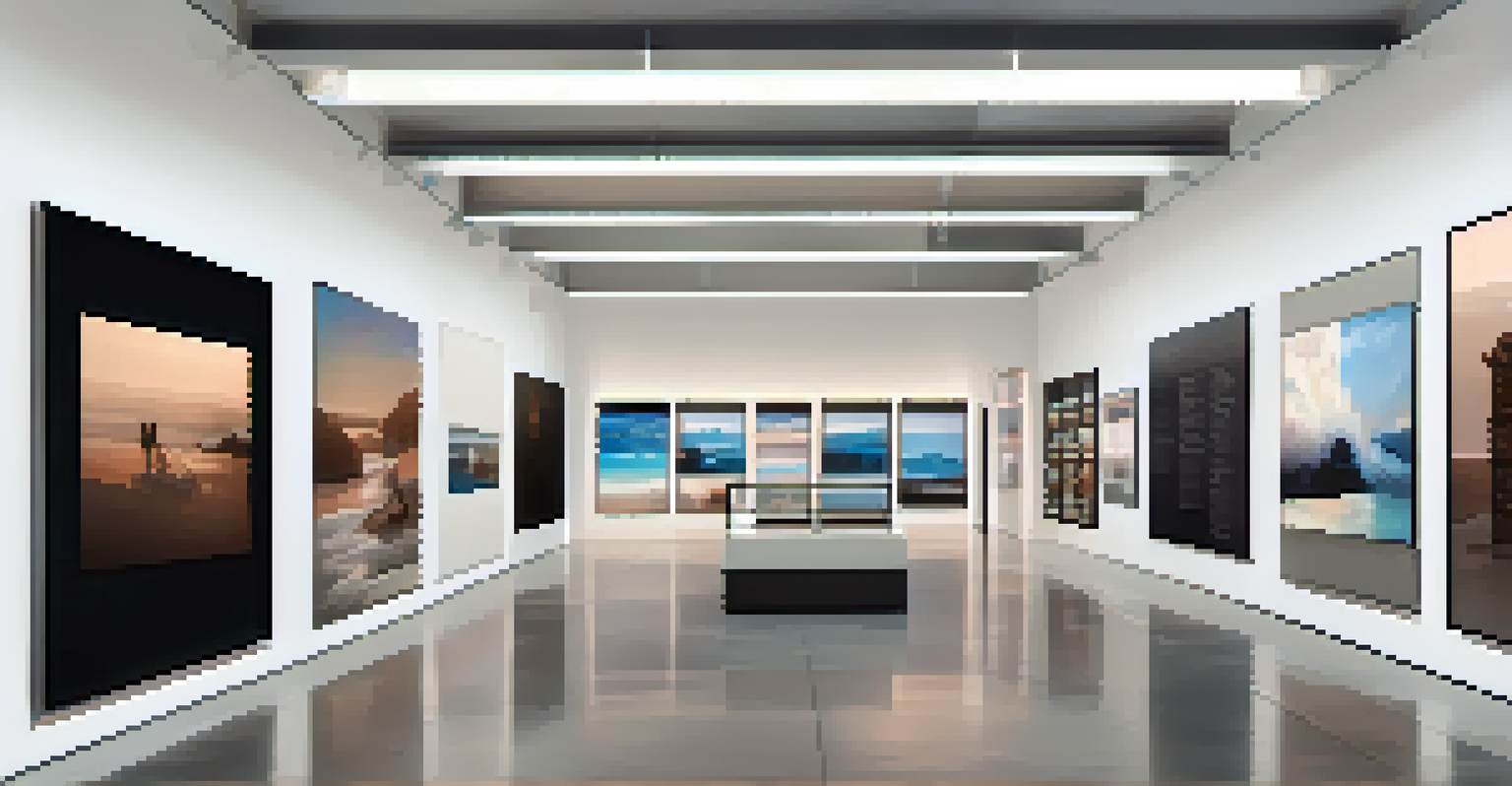Creating and Selling Your First NFT as a Photographer

Understanding NFTs: What They Are and How They Work
NFTs, or Non-Fungible Tokens, are unique digital assets that represent ownership of a specific item or piece of content, often stored on a blockchain. Unlike cryptocurrencies like Bitcoin, NFTs cannot be exchanged on a one-to-one basis because each one has distinct value and characteristics. For photographers, NFTs can be a game-changer, allowing you to tokenize your work and sell it directly to collectors without the need for intermediaries.
Art is not what you see, but what you make others see.
Imagine you have a beautiful photograph that you want to sell. When you create an NFT for this image, it becomes a one-of-a-kind digital collectible, just like a signed print. Buyers can purchase the NFT, and they gain ownership of that original digital piece, verified and secured through blockchain technology. This not only gives your work a unique status but also ensures that you can track ownership and sales over time.
As a photographer, understanding the basics of NFTs is essential before diving into creating and selling them. This new frontier offers exciting possibilities for monetizing your art and connecting with a global audience. Embracing NFTs could not only provide additional income but also help you establish your brand in the ever-evolving digital landscape.
Choosing the Right Platform to Create Your NFT
When it comes to creating your first NFT, selecting the right platform is crucial. There are various marketplaces available, like OpenSea, Rarible, and Foundation, each offering unique features and user experiences. For photographers, it's vital to choose a platform that aligns with your style, audience, and the types of NFTs you want to create, whether they are photos, animations, or digital art.

Consider factors such as ease of use, transaction fees, and the community surrounding each platform. For instance, OpenSea is one of the largest marketplaces, making it a great choice for exposure, while Foundation focuses more on curated content and may require an invitation to list your work. By doing a bit of research, you can find a platform that not only showcases your photography but also supports your artistic vision.
NFTs Empower Photographers
NFTs provide photographers with a unique way to monetize their work and connect directly with collectors.
Once you've chosen a platform, you'll need to create an account and link a digital wallet, which will be used for transactions. This wallet will store your NFTs and any cryptocurrency you may earn from sales. With the right setup, you'll be ready to start creating and listing your first NFT, turning your captivating photographs into digital assets.
Preparing Your Photography for NFT Creation
Before diving into the NFT creation process, it's important to prepare your photographs for this new format. Start by curating a selection of your best work that resonates with your target audience. Consider creating a series or a themed collection, as this can enhance your appeal and attract collectors who appreciate cohesive artistry.
The best way to predict the future is to create it.
Next, think about the file format and resolution of your images. High-quality JPEG or PNG files are typically recommended, but ensure they meet the specifications of your chosen platform. Additionally, consider adding elements like a digital signature or watermark to further authenticate your work and protect it from unauthorized use, especially since the digital realm can sometimes feel less secure.
Finally, write a compelling description for each NFT. This is your chance to tell the story behind the photograph, share your creative process, or explain the significance of the piece. Engaging descriptions can enhance the emotional connection potential buyers feel, making them more likely to invest in your work.
Creating Your First NFT: Step-by-Step Guide
Now that your photographs are ready, it’s time to create your first NFT. Start by logging into your chosen marketplace and navigating to the 'Create' or 'Mint' section. You'll typically need to upload your image file, add a title and description, and select any additional properties or unlockable content, such as a high-resolution file or behind-the-scenes documentation.
Once your NFT is created, you'll also have the option to set royalties, allowing you to earn a percentage of future sales whenever your NFT is resold. This is a fantastic benefit for photographers, as it ensures continued support for your work as it gains value over time. After reviewing all the details, you can confirm the creation of your NFT, which may require a small gas fee, depending on the blockchain's transaction costs.
Choose the Right NFT Platform
Selecting the appropriate marketplace is crucial for showcasing your photography and reaching your target audience.
After minting, your NFT will be listed on the marketplace, where potential buyers can view and purchase it. Take a moment to celebrate this achievement; you've just created a digital asset that showcases your artistry in a whole new way!
Promoting Your NFT: Getting the Word Out
Creating an NFT is just the first step; now you need to promote it effectively to attract buyers. Start by leveraging your existing social media platforms, such as Instagram, Twitter, or Facebook, to share your new NFT with your audience. Use engaging visuals, behind-the-scenes content, and stories to generate excitement and showcase the uniqueness of your work.
Consider collaborating with other artists or influencers in the NFT space to broaden your reach. Partnerships can introduce your work to new audiences and foster a sense of community within the digital art scene. Don't hesitate to join NFT-focused groups or forums where you can share your journey and connect with like-minded creatives.
Lastly, think about running special promotions or offers for your first NFT sale, such as limited-time pricing or exclusive bonuses for early buyers. This can create a sense of urgency and encourage collectors to act quickly, helping you establish a foothold in the competitive NFT market.
Understanding the Legal Aspects of NFTs
As you venture into the world of NFTs, it's essential to grasp the legal aspects surrounding them. Copyright remains a significant concern for photographers, as owning an NFT does not automatically grant buyers the rights to reproduce or distribute your work. Make sure to understand and communicate what rights come with the NFT sale, so buyers know what they can and cannot do with your photography.
Additionally, familiarize yourself with the terms and conditions of the platform you choose to sell on. Each marketplace may have its policies regarding copyright, royalties, and ownership rights, which can impact your control over your work. Protecting your intellectual property is crucial, so consider consulting with a legal professional specializing in digital art and copyright law.
Understand Legal Implications
It's essential for photographers to grasp copyright and ownership rights associated with NFTs to protect their work.
Finally, keep track of your sales, earnings, and any taxes owed, as the NFT space can have tax implications depending on your location. Being informed and proactive about the legalities of NFTs will help you navigate this new territory confidently, ensuring that you can focus on what you love: creating stunning photography.
The Future of Photography in the NFT Space
As the world of NFTs continues to evolve, the impact on photography is becoming increasingly significant. Photographers are finding new ways to monetize their work, engage with fans, and explore creative avenues they may not have considered before. The NFT space is not just a trend; it's a fundamental shift in how digital art is valued and sold.
With the growing interest in NFTs, there's potential for photographers to build their brands and establish themselves as thought leaders in the digital art space. By producing high-quality, unique pieces and actively participating in the community, photographers can carve out their niche and attract collectors who appreciate their artistry.

In conclusion, the journey of creating and selling your first NFT as a photographer is an exciting opportunity to embrace. By understanding the technology, preparing your work, and promoting it effectively, you can take part in this innovative space and potentially reshape your artistic career in the process.